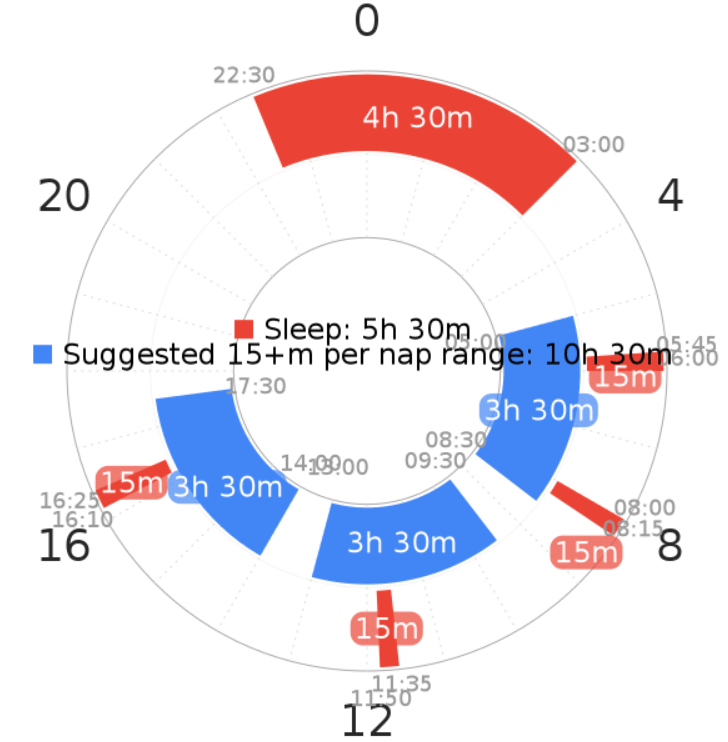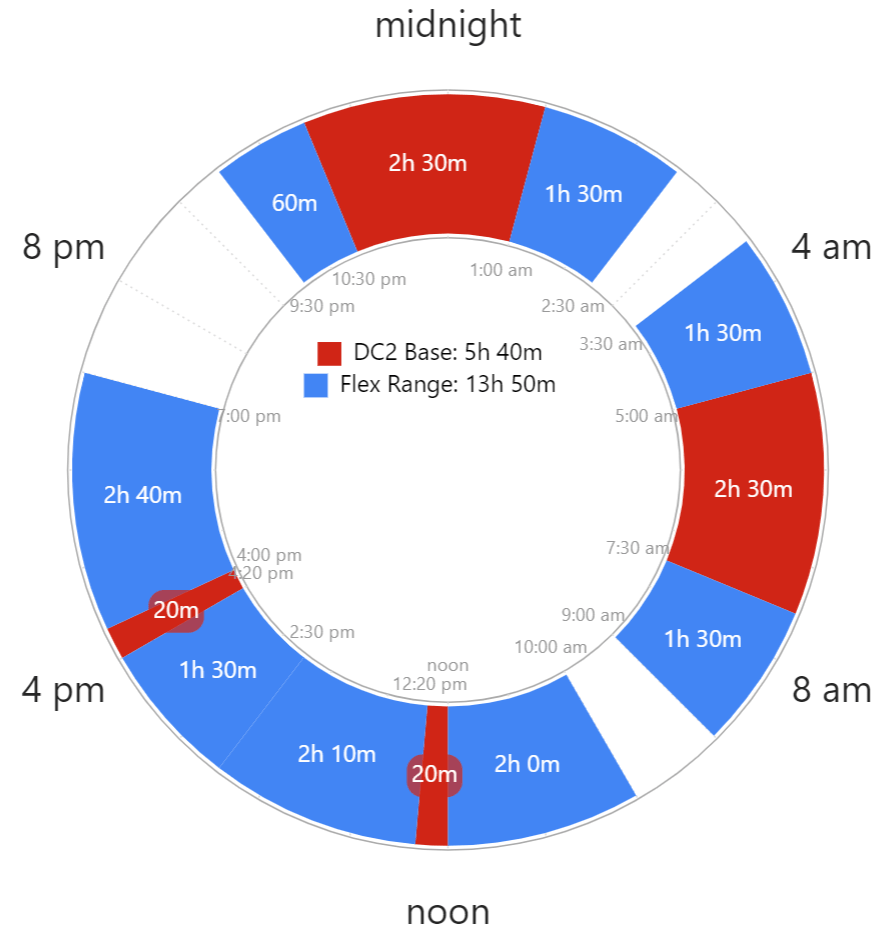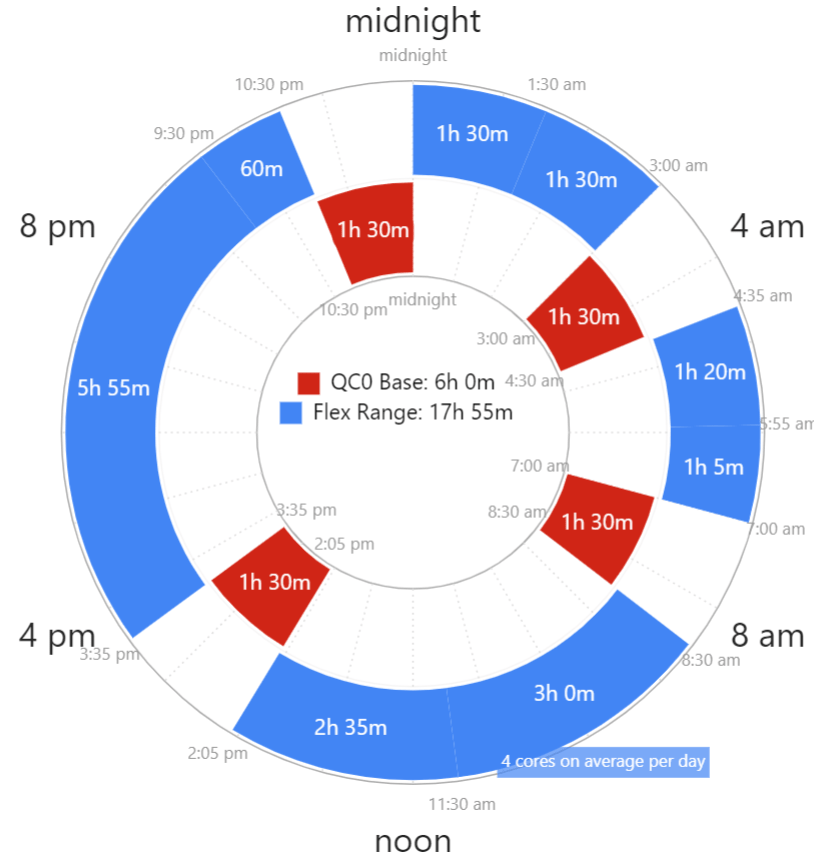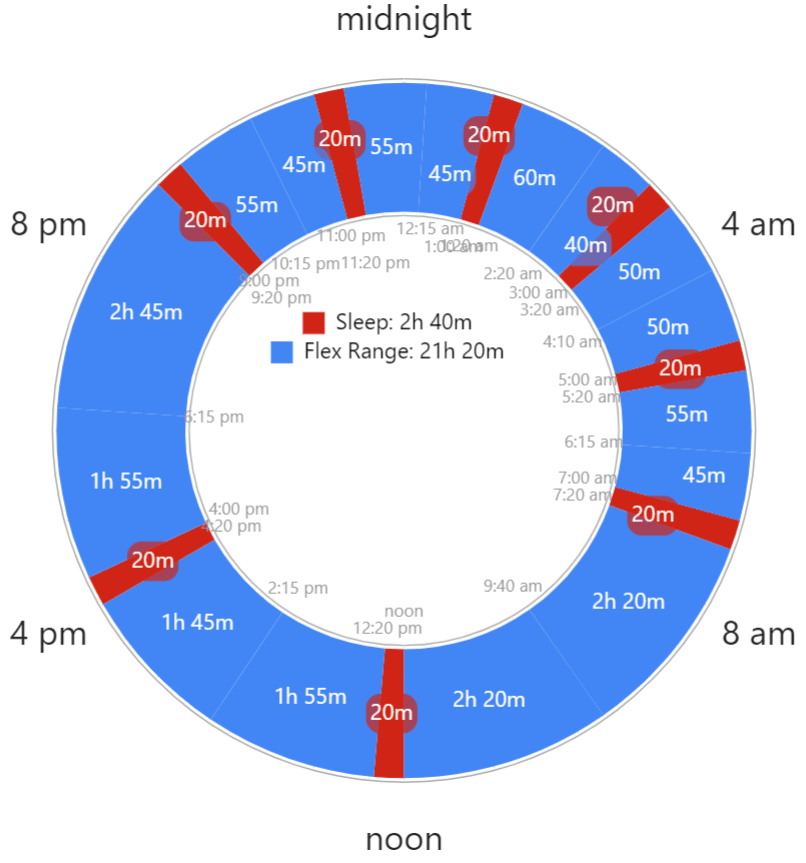FLEXIBLE
Introduction
Human is capable of having flexible sleep schedules. Additionally, polyphasic schedules tend to become more flexible after the first strict adaptation step is completed, although to varying degrees.
Currently, there are 2 different systems of flexible schedules. Note that this post only focuses on reducing polyphasic schedules and their flexibility.
For more information on non-reducing schedules, check out Flexible Sleep Timing.
Regular Flexible Schedules
These are any polyphasic schedules that have strict sleep times at first. Over time, adapted sleepers will learn to make at least one sleep block flexible. It is important to adapt to any reducing schedules first, before attempting to flex any sleep blocks.
To make each schedule flexible, it is also necessary to go through a flexing adaptation.
- The most common route is to gradually flex each sleep block back and forth by small increments (e.g, 15m, 30m).
- Then, each flex range can increase if there is more demand for a bigger flex range.
- The flexing adaptation usually lasts anywhere from 4-8 weeks or more depending on how flexible each sleep block, or the whole schedule is.
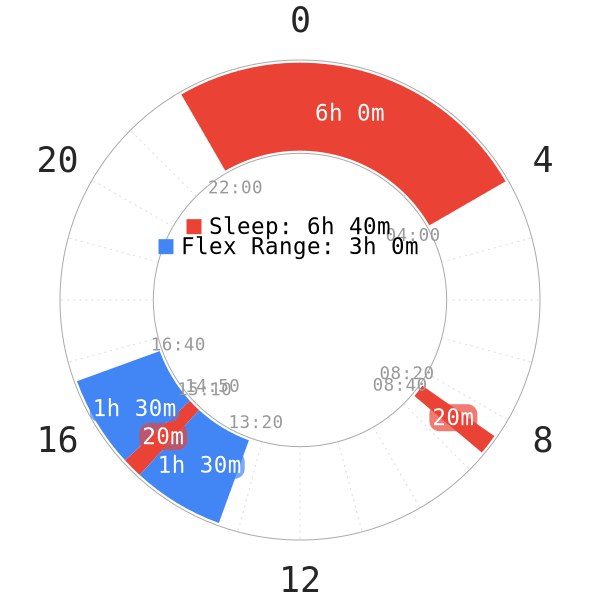
The above napchart shows an E2 variant with a flexible second nap.
- The nap has a flex range of 90 minutes in either direction. It suggests that the sleeper can take the nap 90 minutes sooner or later than the strict sleep times from the first adaptation to the E2-extended base.
- This flex range also indicates that the sleeper has been able to flex the second nap with any range smaller than +/-90 minutes (e.g, 40m sooner or 60m later than the original time) if desired.
- However, in this case, the core sleep and the first nap remain at the same hours as the original sleep times. The remaining waking hours are untouched.
Similarly, any other regular, slightly flexible schedules will have at least one flexible sleep block while the remaining waking hours resemble those on the first strict adaptation.
For the purpose of clarification, any in-progress adaptation to flexible schedules usually contains a suffix “-flex” behind the schedule name. For example, E2-ext-flex in the example above. Other examples include: DC1-flex, E1-flex, E2-modified-flex, etc.
Flexible“-Amayl” (“as much as you like”) schedules
Definition
These schedules (e.g, SEVAMAYL) require that sleepers have highly enhanced flexing skills. They are comfortable with sleeping around the clock. They are capable of such feats while maintaining productivity, well-being and other successful adaptation criteria.
- The defining distinction is that “-amayl” schedules have somewhat variable number of sleep sessions from day to day, within a certain general structure. For example, SEVAMAYL will have 1 core but a variable number of naps. This is similar to a general Everyman schedule’s structure but the number of naps can vary on a daily basis.
- “-Amayl” sleepers have become capable of sleeping whenever they are tired enough. This is because their sleep remains efficient enough to provide the necessary vital sleep stages.
- Despite their versatility, they require paying some attention to wakefulness and alertness dips; sleepers should rest after getting somewhat tired, but before getting too tired and risking an oversleep.
- The close monitoring of homeostatic pressure to achieve efficient sleep can make “-amayl” schedules difficult to manage across a wide range of possible sleep times.
Below is an example of a SEVAMAYL variant.
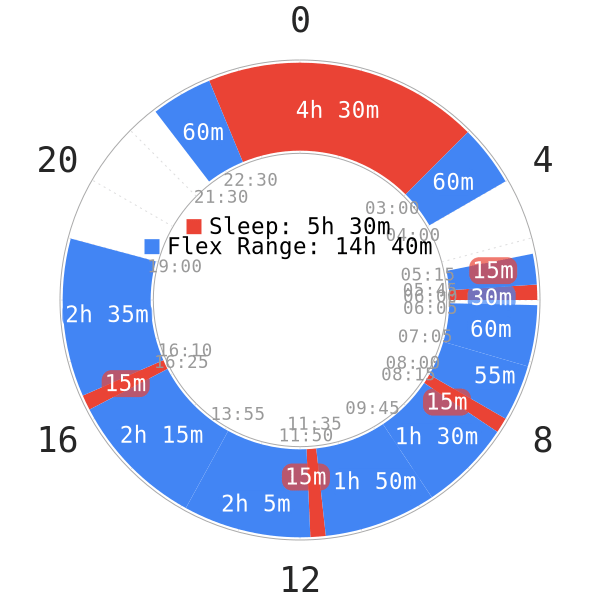
- The SEVAMAYL sleeper in the above napchart is able to flex the core by 60 minutes in either direction.
- They can also flex all the naps to various degrees; any naps between 05:15 and 19:00 are comfortably adjusted.
- Because of the core sleep at night, there is no napping at evening hours.
- The freedom to nap whenever tired during the daytime hours is very satisfying.
- In order to adapt to SEVAMAYL, a strict adaptation to a base Everyman schedule (e.g, E3-extended) is obligatory. After that, adapt to the flexible intermediate E3-extended with gradual increases in flex range of each sleep block. Then, one can finally reach SEVAMAYL.
Adaptation Mechanics to Flexible Sleep
Adaptation-wise, “-flex” schedules are good intermediate steps for adaptations to “-amayl” schedules.
- This helps ease polyphasic sleepers into flexing sleep.
- All successes on flexible schedules take place after a successful adaptation to the strict base. For example, a flexible nap from E1, DC1-ext nap or either of the 2 cores from DC1-ext.
- Rare exceptions exist, especially for those with genetically reduced monophasic sleep requirements.
- Because of the massive flex ranges of sleep blocks on “-amayl” schedules, adaptations to them are supposed to be harder than to flexible schedules.
Additional Features of Flexible “-Amayl” Sleep Schedules
- As an additional aspect of schedule malleability, adapted “-amayl” schedules may include somewhat variable sleep block lengths. This means having fewer or more sleep blocks on any given day.
- However, normal, reducing flexible schedules do not seem to support variable sleep durations. This can negatively affect repartitioning of vital sleep stages in each sleep block.
- It is too difficult to retain well-being with a defined number of naps that should each last consistently less than ~23 minutes (e.g, Everyman). At the same time, drastically altered architecture of the core sleep also makes reliable compensation difficult without variable numbers of sleeps.
- Not any schedules can take the “-amayl” form.
- Any schedules have to be able to show the ability to change the number of sleep blocks from day to day or at least occasionally.
- They have to maintain polyphasic characteristics to be “-amayl”. For example, a Segmented pattern with 2 core sleeps of 3 hours each cannot become “Segmented-amayl”. If a sleeper skips one of the 2 cores on some days, the whole schedule would become monophasic sleep.
Example
The example below demonstrates this concept.
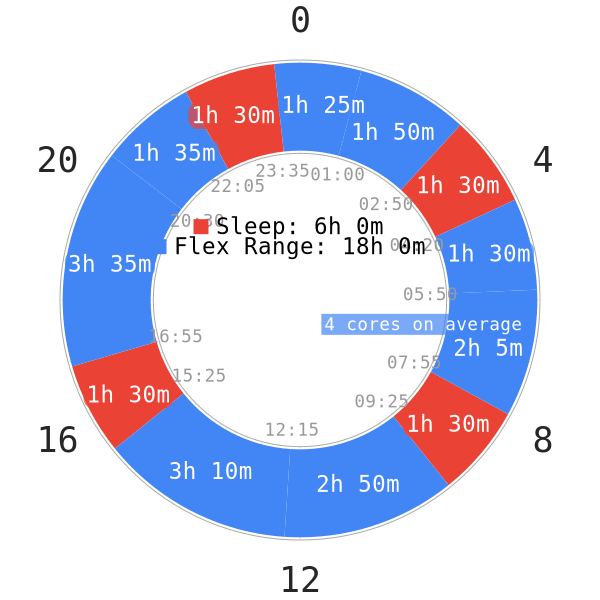
The above napchart represents a CAMAYL version with usually 4 core sleeps each day. The sleeper has demonstrated the ability to sleep for 90 minutes whenever tired enough. However, on days where it is mandatory to skip one core, the schedule takes the following form below.
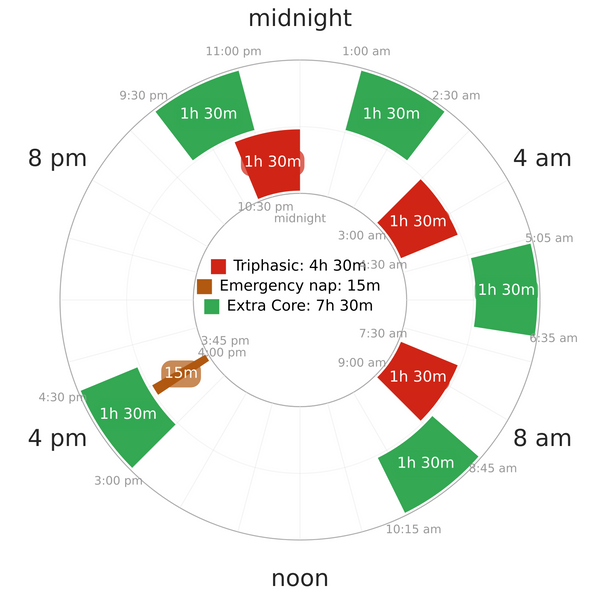
- Once the adaptation phase is complete, skipping one core for a day only raises homeostatic pressure to reasonable levels.
- It is then possible to make up for the lost core by adding a core the following day (taking 5 cores instead). This is to recover from the lost sleep the previous day. The core addition is also equivalent to taking 4 cores on usual days.
- Alternatively, extending one of the cores to 3 hours can also do the job if scheduling 5 cores is too challenging.
- Similarly, the occasionally lowered number of naps on SEVAMAYL enable the 90m core extension or extra naps the following day to rebalance homeostatic pressure.
Sleep Everyman As Much As You Like (SEVAMAYL)
- Proposed by: Aethermind
- Total sleep: Undefined, but may average around 5-6 hours
- Classification: Flexible schedule, SPAMAYL variant, Everyman variant
- Specification: 1 core, multiple short naps
- Mechanism: Variant of SPAMAYL that includes a core sleep. Evolves well from adaptation to E3-extended, then E3-extended-flex as a helpful intermediate. The core sleep provides SWS and some REM, with several naps providing the remaining REM. A strong reliance on sensing when to best nap to get quality REM naps is necessary. You will need the freedom to take a nap soon at any time, and/or the ability to plan naps sensibly for each day to avoid excessive tiredness from long wake gaps.
- Adaptation difficulty: Hard
- Ideal scheduling: Around a 4-5 hour core, with about 2-6 naps of 10-20 minutes in length. Favor natural wakes. Cycles may naturally compress to 80m with frequent sleeps. Plan for 90m cycles until there are many early natural wakes. Nap spacing should take into account natural periods of tiredness, as well as the morning circadian peak. In the evening, 6-7 hour gaps are common; however, alertness may wane after 3-4 hours awake in the morning. A longer Pronap of up to 45m might be plausible during REM peak (6-9am) if the core already covers all SWS requirements; this should be the case if the base strict schedule has already been adapted to. This would allow larger gaps and/or increased flexibility later in the day. The core might be flexed and/or varied max. 90m in length, as optional variables after adapting to a base schedule. It is not advisable to add an extra cycle more than once a week; more frequent lengthening seems to destabilize adaptations to the reduced sleep total.
Dual Core As Much As You Like (DUCAMAYL)
- Proposed by: The Discord Polyphasic Community
- Total sleep: Undefined, but may average around 5.5-6.5 hours
- Classification: Flexible schedule, SPAMAYL variant, Dual Core variant
- Specification: 2 cores, multiple short naps
- Mechanism: Variant of SPAMAYL that includes 2 core sleeps. Evolves well from adaptation to DC1-extended, DC2-(extended) and DC3-extended. Then, adapt to flexible versions of these schedules as helpful intermediates. The first core sleep provides more SWS while the second core favors more REM. The nap(s) provide the remaining REM. The schedule relies on sensing tiredness patterns to get quality REM nap(s) and quality cores. You will need the freedom to take a nap soon at any time, and/or the ability to plan naps sensibly for each day. Ultimately, there should be no wake period too long that makes you tired.
- Adaptation difficulty: Hard
- Ideal scheduling: ~At least ~4.5-5h total sleep for both cores combined, with about 1-4 naps of 10-20 minutes in length. Nap spacing should take into account natural periods of tiredness, as well as the morning circadian peak. In the evening, 6-7 hour wake gaps are common, whereas alertness may wane after 3-4 hours awake around night/early morning hours. A longer Pronap of up to 45m might be plausible during early morning hours (6-10am) if all SWS has sufficed; this should be if one has adapted to the base strict schedule. The longer nap would allow longer wake periods and/or increased flexibility later in the day. The wake gap between 2 cores can increase or decrease depending on days. Each core might be flexible and/or varied max. 90m in length. It can be detrimental to add an extra cycle to a core more than once a week; this can destabilize adaptations to the reduced sleep total.
Core As Much As You Like (CAMAYL)
- Proposed by: GeneralNguyen
- Total sleep: Undefined, but average to be 6h
- Classification: Flexible schedule, SPAMAYL variant, Multi-core variant
- Specification: Multiple core sleeps of 1 cycle each
- Mechanism: Variant of SPAMAYL that includes only core sleeps. Evolves well from adaptation to QC0 and then QC0-flex as a helpful intermediate. Each core sleep provides a distinct amount of sleep stages depending on when they are placed and the level of current homeostatic pressure. A strong reliance on sensing when the most ideal time to place a core is. The freedom to place a core soon in the day at natural tired/sleepy spots is mandatory to make the schedule work. This is to avoid excessively long wake gaps that result in tiredness and potential crash later on.
- Adaptation difficulty: Hard
- Ideal scheduling: 4 core sleeps on average each day; each core sleep lasts for 90m. Core spacing should take into account natural periods of drowsiness and SWS/REM peaks. It is more common to stay awake for longer periods in the day (6+ hours) while shorter periods around graveyard/morning hours (2-3h) between each core. A core sleep can extend to 3h after adaptation to make up for a missing core from the previous day. A short nap (10-15m) can be occasionally added to the schedule (after adapted) for a long wake gap that does not allow a full core. The number of cores taken each day may vary everyday or on an occasional basis.
Sleep Polyphasically As Much As You Like (SPAMAYL)
- Proposed by: Rasmus
- Total sleep: Undefined, but on average 2.5 hours (7-8 20-minute naps per day)
- Classification: Nap-only schedule, Flexible schedule
- Specification: Multiple short naps
- Mechanism: No rhythm, there have to have more than 6 20-minute naps per day on average.
- Adaptation difficulty: Extreme
- Ideal scheduling: Most naps should be spread during graveyard hours to avoid the need to nap a lot during the day with work, social life, etc.
Comparison between “-AMAYL” schedules
NOTE:
- The assessment table showcases differences between “-AMAYL” schedules, based on standard scheduling.
- Unless specified otherwise, there are no mentions on extended versions.
- The table accounts for short sleepers and insomniacs who adapted to SPAMAYL; thus, these criteria will likely vary between schedules.
- Assessment denotations:
- 4/4: Positive, very high viability, or very easy
- 3/4: Somewhat decent viability, above average, or somewhat easy
- 2/4: Neutral, medium viability
- 1/4: Overall negative, low viability, below average, or difficult
| Criteria | SEVAMAYL | DUCAMAYL | CAMAYL | SPAMAYL |
| Exercising | ||||
| Time zone travel (> 5h) | ||||
| Evening social time (18:00-23:00) | ||||
| Daytime sleep (07:00-17:30) | ||||
| Schedule sleep around meal time | ||||
| Overall flexibility | ||||
| Flexible core(s) | N/A | |||
| Hidden potential(s) | Variable nap duration | Variable nap duration, flexible night gap | Varying core duration, short nap in emergency | Longer nap duration |
| Criteria | SEVAMAYL | DUCAMAYL |
| Exercising | ||
| Time zone travel (> 5h) | ||
| Evening social time (18:00-23:00) | ||
| Daytime sleep (07:00-17:30) | ||
| Schedule sleep around meal time | ||
| Overall flexibility | ||
| Flexible core(s) | ||
| Hidden potential | Varying nap duration | Varying nap duration, flexible night gap |
| Criteria | CAMAYL | SPAMAYL |
| Exercising | ||
| Time zone travel (> 5h) | ||
| Evening social time (18:00-23:00) | ||
| Daytime sleep (07:00-17:30) | ||
| Schedule sleep around meal time | ||
| Overall flexibility | ||
| Flexible core(s) | N/A | |
| Hidden potential(s) | Varying core duration, short nap in emergency | Longer nap duration |
Brief Analysis
- SPAMAYL is the only “-AMAYL” schedule without a core sleep.
- CAMAYL is the only schedule without any naps.
- All schedules (except CAMAYL) can extend their naps (e.g, 40m) or 60m in the case of SPAMAYL.
- The most dominant feature all schedules has is the ability to alter the amount of naps (or CAMAYL cores) from day to day.
- Because of the high flexibility, all these schedules score positive signs in almost every scheduling aspect.
- CAMAYL is possibly the least ideal schedule because the core sleeps are socially intrusive.
- Currently, DUCAMAYL has the most disadvantages in travelling > 5h time zone change. This is because such travelling events can fracture the dark period before and between the cores.
- SPAMAYL is the most difficult schedule, with possible long-term health effects because of the nap-only behavior. In addition, its erratic napping behavior makes for a disgusting adaptation.
- The most popular and successful schedule is SEVAMAYL. It builds on the designs of the popular Everyman system. SEVAMAYL is also possibly the most convenient schedule long-term because the core sleep occupies most night hours.
- The common weakness of all “-AMAYL” schedules seems to be the consistent, long daily wake periods that do not allow any sleep. As a result, consistent “9-to-5” work or regular school hours would limit the flexibility and freedom of sleep times.
Overall, “-AMAYL” prototypes are satisfying in their own way once adapted. Their flexibility and enhanced utility make for a viable long-term approach if the appropriate lifestyle allows.
Main author: GeneralNguyen
Page last updated: 8 April 2021









